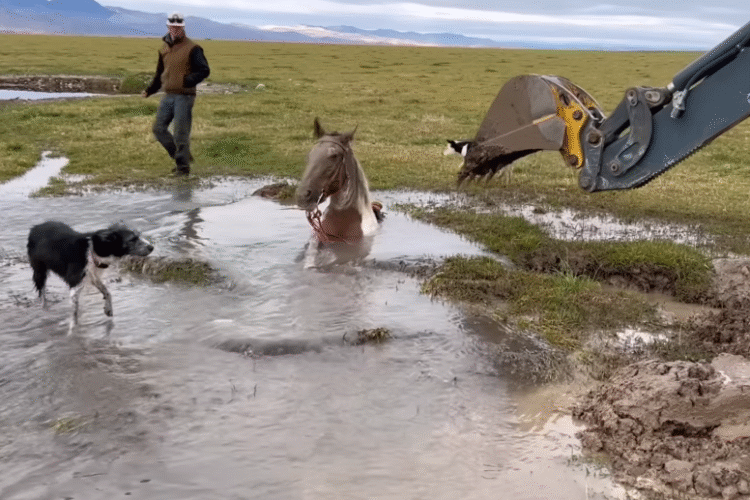A Trapped Horse, a Rural Emergency
In a heart-pounding scene that unfolded on a quiet stretch of farmland, a horse found itself in serious danger after becoming trapped in a deep patch of mud. The weight of the horse and the slick, sticky terrain created a nearly impossible situation, one that could have turned tragic if not for the quick thinking and teamwork of a few determined individuals.

The image captures the tense moment: a large horse lying helpless in a water-filled mud hole, with a tractor’s backhoe gently lifting the animal’s front end using a rope harness. Onlookers and helpers — including a rancher, a utility vehicle driver, and even a curious dog — gathered to assist in any way they could. This was not just a rescue; it was a moment of rural bravery, resourcefulness, and compassion.
The Dangerous Grip of Mud
Mud might seem harmless, but to a large animal like a horse, it can be deadly. Once stuck, the more a horse struggles, the deeper it can sink. The suction of wet soil around a horse’s legs and body creates enormous resistance, preventing the animal from freeing itself. Horses are also prone to exhaustion and injury in such situations, making a swift and strategic rescue essential.
In this case, the horse had likely wandered into a low-lying area that had become waterlogged after recent rains. Before anyone realized the danger, the animal was belly-deep in thick muck, unable to stand or move. Time was of the essence.
Tools, Teamwork, and Careful Planning
Rather than risking further injury by pulling the horse with brute force, the rescuers acted with precision. A tractor was brought in — not for heavy lifting, but to assist gently. A backhoe, typically used for digging, was repurposed into a lifeline. With a rope harness tied carefully around the horse’s torso and neck, the hydraulic arm of the machine slowly and cautiously lifted, just enough to help the horse regain footing and relieve some pressure on its trapped body.

Throughout the rescue, handlers remained calm and attentive. One person stayed near the horse’s head to soothe it, while another operated the backhoe with incredible delicacy. The dog, although not an official part of the rescue crew, seemed to keep watch in solidarity — a reminder of how animals often sense distress and stand by their companions.
A Safe and Successful Outcome
After several tense minutes of lifting, coaxing, and shifting, the horse was finally free. Though tired and muddy, the animal stood up on all fours and was led to dry, solid ground. Spectators let out a collective breath of relief. It was a testament to human compassion, and a vivid reminder that living in harmony with animals means being ready to help them when they need us most.
The success of this rescue was not just about strength, but about empathy, intelligence, and teamwork. The machine played a crucial role, but it was the people who made the difference: observing the horse’s reactions, adjusting their efforts, and ensuring that safety came first — for both animal and humans.
Lessons from the Mud
This rescue highlights a few important takeaways for anyone living or working with animals in rural areas:
- Always survey pastures and fields for soft ground after rains, especially in spring and fall.
- Train with rescue equipment and have a plan in place for large-animal emergencies.
- Never panic — calm energy helps keep animals steady during stressful events.
- Use machinery wisely — it can save lives when used with care and understanding.
Conclusion: Compassion in Action
The story of this horse rescue is more than a dramatic photo. It’s a powerful example of what happens when humans step up to help animals in distress. Whether on a farm, in the wilderness, or even in a city park, animals sometimes need our help — and when they do, it’s heartening to know that there are people ready to act with courage, care, and kindness.

This moment, captured in an unforgettable image, serves as a reminder that rescue isn’t just a job — it’s a calling for those who truly care.
